

| devpsy.org > teaching > method > confirmation bias | k h g @ d e v p s y . o r g |
Interactive class activity to demonstrate the confirmation bias adapted from Wason (1960) 2-4-6 Hypothesis Rule Discovery Task. Engaging way to introduce research methodology in Psychology or other science classes. Provides a concrete example falsifiability in Karl Popper’s Philosophy of Science for Philosophy classes.
We actively try to support whatever we already believe rather than trying to find out how we might be wrong. We interpret ambiguous or mixed information to confirm our existing theories. This natural inclination in our thinking is called the confirmation bias. This class activity builds on Peter Cathcart Wason’s (1960) 2-4-6 Hypothesis Rule Discovery task to surprise students with how easily their thinking can be led astray. For Psychology classes it provides an engaging experience to introduce research methodology. For Philosophy classes it provides a concrete example to discuss the need for falsifiability in Karl Popper’s Philosophy of Science. I use it on the first day of Social Psychology to introduce how the role of construal shapes the power of the situation in our everyday lives.
Pass out a copy of the confirmation bias handout to each student. Though all the instructions are on the handout, I have found the activity works best if I slowly and deliberately take students through the instructions with these confirmation bias powerpoint slide. Once you begin playing the 2-4-6 game, you will have to move about the room quickly; stopping to clarify instructions for a few students would disrupt the flow.
A sequence of numbers has an order to it. For example, 1-2-3 is a different sequence from 3-2-1. Some sequences of 3 numbers make me incredibly happy; other sequences of 3 numbers make me very sad. Your goal is to figure out the rule for what sequences make me happy. But you can't simply ask me my rule. Instead you can conduct experiments on me. You can make up a 3 number sequences and I'll tell you if it makes me happy. Then you can make up another sequence, I'll tell you again, and we'll keep going until you're mostly confident you know the rule inside my head. I have the same rule for everyone in class, but please don't peek. When we're done everyone will know the rule for what sequences make me happy. Let's do the first sequence together. 2-4-6. I already wrote it on your paper. After you write the sequence I'll come by and write a happy or sad face for you in the "fits my rule" column. It turns out the sequence makes me very happy! I also wrote that already on your paper. Now that you have feedback from me, you should make your best guess for the rule that makes me happy. For example, you might guess, "counting up by 2's." If that's your guess write it in this blank, or you can feel free to write another hypothesis. To finish the row, you should make a rough estimate for how certain you are that the rule you guessed really is the rule for sequences that make me happy. If you have absolutely no confidence and your guess is basically random, write 0%. On the other hand, if you are totally sure you have it, write 100%. I wrote 50% here [on slide] to start, but you should feel free to put any percent from 0 to 100.
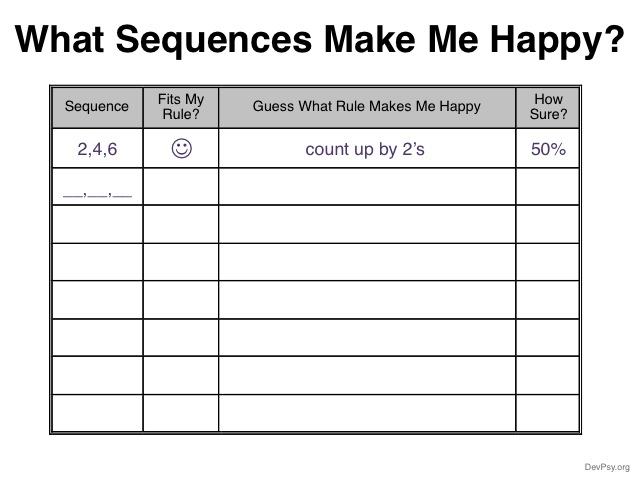
Now it's your turn. Write your own sequence of 3 numbers to test me. THEN WAIT UNTIL I GIVE YOU A HAPPY OR SAD FACE. Once I give you feedback, write your hypothesis. If it's the same as before, feel free to put the ditto marks. Say how sure you are with a percent. Then make another sequence to test what rule makes me happy. Once you're 100% confident, feel free to turn over your paper so I skip you.
If you have a class of about a dozen students, it is pretty easy to cycle through students for many rounds. If you have two dozen students, this requires you to cycle pretty quickly to avoid students getting bored. I suggest you make sure people put backpacks and other obstacles under desks before you begin. I also recommend just saying, "happy" or "sad" softly to students an have them fill in the column. This speeds up your pace. If you have three dozen or more students, I recommend having help such as a TA's or former students who can divide up the room with you.
I'll give you the rule below; I recommend you generate one sequence now so you can experience a little of the game.
Normally I only play for about 5 rounds. At this point about half the class is 100% sure and most of the rest have a high percent. It's helpful if you make a mental note of who in your class has the correct answer before you poll the class.
Even if you're not 100% sure, let's see what rules you figured out. I normally write the rules on the board and write a count from the show of hands beside it. I begin by guiding the responses.
How many of you ended with the rule, "count up by 2's?"
How many of you ended with the rule, "count up by a multiple," such as 3,6,9 and 5,10,15?
How many of you ended with a rule that's a formula like add the first two numbers for the third number?
Anybody have another rule? Here you should delay calling on students you know have the right answer until any other rules are mentioned.
Typically about 80% of class has one of the first three rules and 20% has the correct answer.
The correct answer is that any increasing sequence of numbers makes me happy.
Why did so many of you become so confident about a wrong answer?
I normally jokingly add, "Maybe more interestingly, how come I was so confident you would miss it that I animated that on the slide before class?
It's normally pretty intuitive to students how they played the game and why it went wrong (see animated gif below).
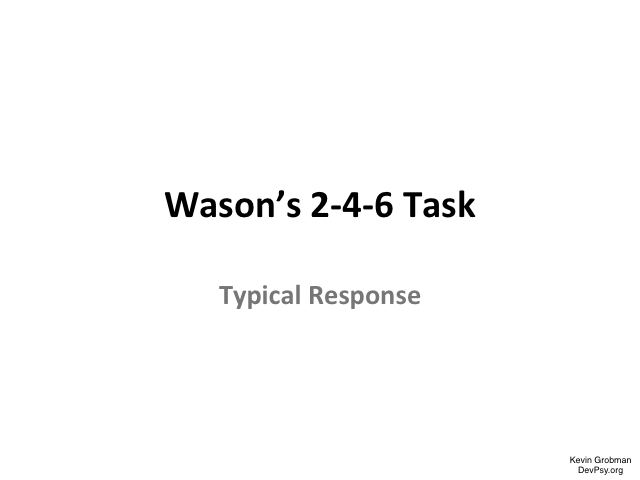
Draw out of them how they had an idea and then kept testing the idea with things that work. That led them to become more and more confident. But they didn't see that really many possible rules could account for all those examples.
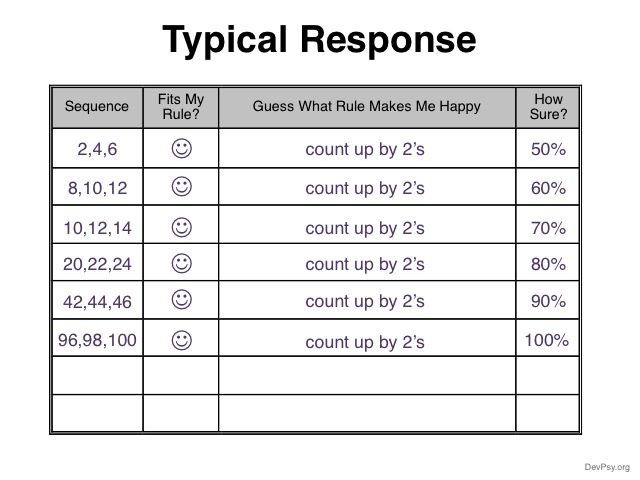
We actively try to support what we already believe rather than trying to find out where we might be wrong. We seek out information that confirms our view. We interpret ambiguous or mixed information to confirm our existing theories (e.g., Darley & Gross, 1983).
This confirmation bias is one of the many natural inclinations we have in our thinking and decision-making.
It's usually a bit more challenging for students to figure out how they should have played to figure out my rule (see animated gif below). Even this difficulty highlights how intuitive the confirmation bias is, and how counter-intuitive it is to think differently.
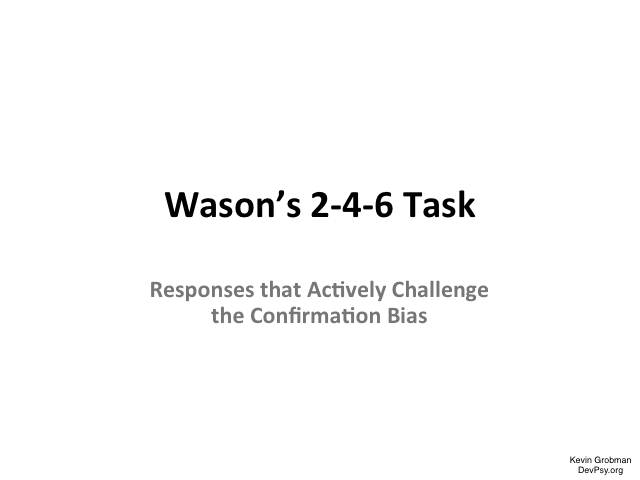
Draw out of students how they needed to actively challenge their preconception by conducting experiments that could falsify their hypothesis. That is, the only way to show you're right, is to try and show you're wrong.

Is the confirmation bias merely a neat trick we can use to fool people in a little game? Or is it more broadly applicable to everyday life? Examples?
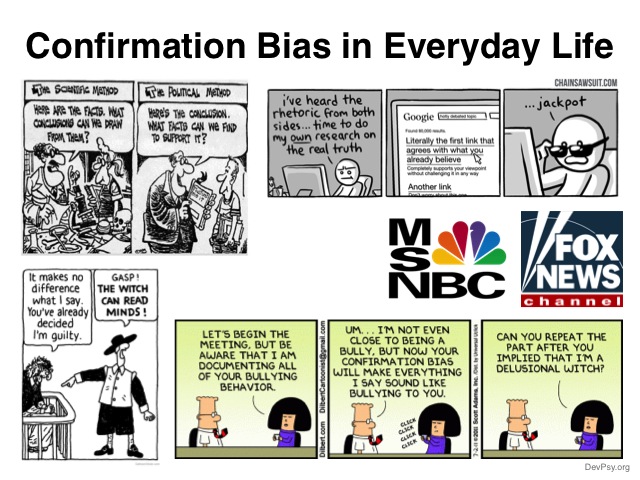
The examples students might generate are seemingly endless. Some examples include:
The original 2-4-6 Hypothesis Rule Discovery Task was created by Cognitive Psychologist Peter Cartcart Wason. Here is the original citation and record sheet.
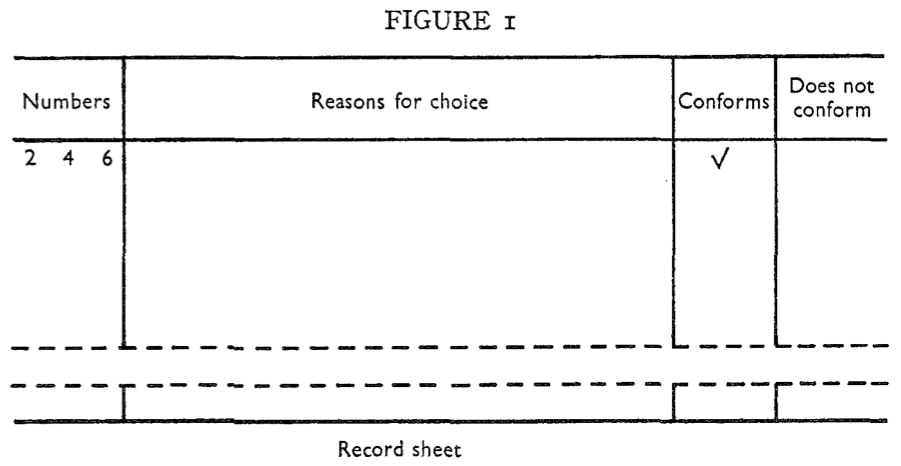
Wason, P. C. (1960). On the failure to eliminate hypotheses in a conceptual task. The Quarterly Journal of Experimental Psychology, 12, 129-140.
The original adaptation for this class activity was created by Kevin Grobman in 2001 and was published on DevPsy.org in 2003. Over the years I polished the handout and slides, as well as improved the clarity with which I share it with other teachers. This page was revised with these improvements in 2017. In 2018 the American Psychological Association (APA) Society for the Teaching of Psychology (STP) included it in an ebook of lab activities for high school Psychology classes.
Please use the following citation for this webpage, slides and handout:
Grobman, K. H. (2003). Confirmation Bias: A class activity adapted from Wason’s 2-4-6 Hypothesis Rule Discovery Task. Retrieved from: http://www.DevPsy.org/teaching/method/confirmation_bias.html
| devpsy.org > teaching > method > confirmation bias |
| Kevin Grobman | k h g @ d e v p s y . o r g | © 2003 - 2018 |